Lake Garden
Most guests would not consider a lake to be a garden! A stroll through the lake garden may take you across an arched bridge, along a boardwalk, or over one of seven other bridges. There is even a floating bridge!
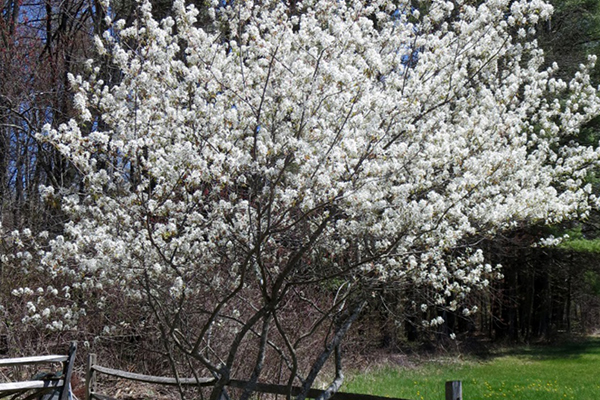
Serviceberry
Common Name: Serviceberry
Botanical Name: Amelanchier
Height: 10–25 feet
Spread: 4–15 feet
Location: Full sun to part shade
Bloom: April, white
Hardiness zone 4–9
In its natural setting, Amelanchier is normally an understory tree or more commonly a large shrub, although it can survive in an open setting with proper irrigation. At maturity, this plant grows 10 to 25 feet tall. The 3-inch oval shape leaves appear in spring with bronze tints changing to a dark green for the summer then changing again to yellow, reds and oranges for great fall color. The fragrant white flowers bloom in April followed by edible berries that can be used in jellies and jams.

Green Velvet Boxwood
Common Name: Green Velvet Boxwood
Botanical Name: Buxus
Height: 3–4 feet
Spread: 3–4 feet
Location: Full sun to part shade
Bloom: Insignificant
Hardiness zone 4–9
Green Velvet is a wonderful evergreen that has a natural rounded form with no pruning required except to remove any damaged or dead branches. It keeps its color through the winter but can turn a brownish yellow color from dehydration if planted in a windy spot. It grows only 3–4 feet in maturity and can give structure and foundation to any garden. Boxwood is often used as a hedge, in a border, or as a background for a smaller garden.
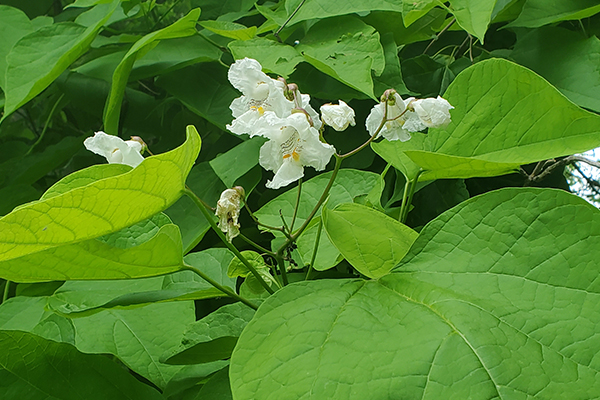
Northern Catalpa Tree
Common Name: Northern Catalpa Tree
Botanical Name: Catalpa speciosa
Height: 40–60 feet
Spread: 20–40 feet
Location: Full sun to part shade
Bloom: May–June, white
Hardiness zone 4–8
The Northern Catalpa has large, up to 12-inch oval, almost heart-shaped leaves that are an easy identifier for this tree. They emerge in the spring a light green and hold that color through the season, turning yellow in the fall. The showy, orchid-like flowers growing in large panicles are a real showstopper. Following the flowers are long, slender green seedpods that mature to a dark brown in the fall. The seedpods dry, then split open, releasing the seeds and helping this plant to naturalize an area if not controlled.
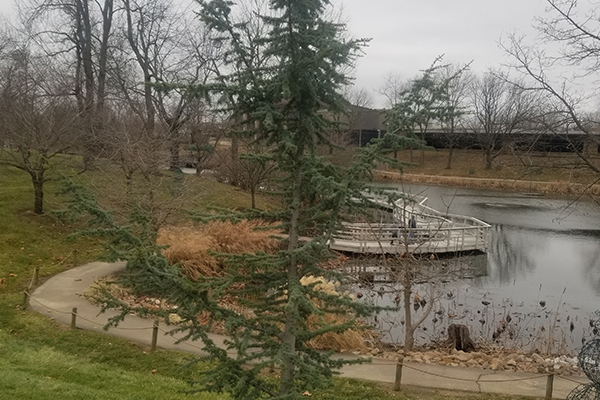
Cedar of Lebanon
Common Name: Cedar of Lebanon
Botanical Name: Cedrus libani
Height: 40–60 feet
Spread: 40–60 feet
Location: Full sun
Bloom: non-flowering
Hardiness zone 6–7
The Cedar of Lebanon is a great symbol of strength, endurance, and immortality through the blood of Christ! Mentioned multiple times in the Bible, this cedar was so sought after for construction and other uses that it was almost driven to extinction. Now it stands strong, growing to 60 feet with branches close to the size of the truck on mature specimens. A great, historic addition to any garden, give this evergreen tree some room wherever you plant it.

China Girl Holly
Common Name: China Girl Holly
Botanical Name: Ilex mesog
Height: 8–10 feet
Spread: 6–8 feet
Location: Full sun to part shade
Bloom: April to May, White flower
Hardiness zone 4–9
China Girl is a popular evergreen shrub that has a very dense and rounded growth habit. Shiny, dark green leaves stay on the plant year-round, making it a great foundational plant for any landscape. Red berries appear in the fall and persist into the winter, adding seasonal color. China Holly is dioecious, meaning that you will also need to plant a China Boy as a pollinator to have the berries on the China Girl. One China Boy will usually pollinate most residential landscapes. This is a hardy, disease-resistant plant, but you will need to watch for some unwanted insects, including scale, and treat as needed.

Shrevei Southern Blue Flag
Common Name: Shrevei Southern Blue Flag
Botanical Name: Iris virginica
Height: 3–3.5 feet
Spread: 2.5–3 feet
Location: Full sun to part shade
Bloom: May, purple flower
Hardiness zone 4–9
Iris is an easy-to-grow, aquatic marginal, but it can become invasive if not cared for properly. We have Iris in several gardens, and it always preforms well under various conditions. Southern Blue Flag is a perennial iris that forms a dense clump of bright green, sword-shaped leaves. The tall stems rise above the foliage boasting violet-blue flowers with a yellow splotch in the middle, that are 3 inches across. This plant is very pest, disease, and deer resistant.
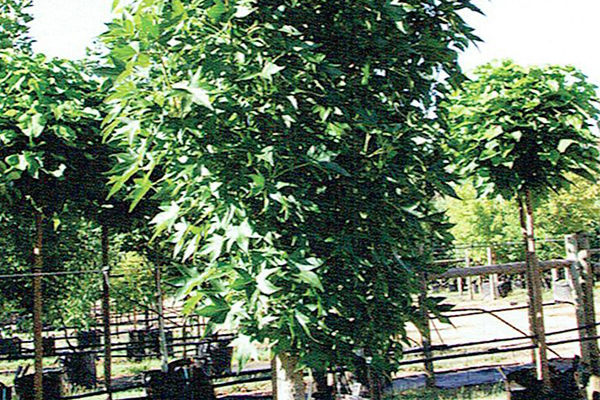
Slender Silhouette Sweetgum
Common Name: Slender Silhouette Sweetgum
Botanical Name: Liquidambar styraciflua
Height: 40–75 feet
Spread: 4–8 feet
Location: Full sun to part shade
Bloom: Inconspicuous white
Hardiness zone 5–10
Slender Sweetgum is known for its very narrow shape, making it fit into tight gardens spaces adding a striking vertical accent. It also has unique star-shaped leaves that produce yellow, red, and purple fall color. Some Sweetgums produce large spiky, ball-shaped fruit that can be a nuisance in your yard. This variety has a much smaller fruit, and it falls in a small narrow area the size of the tree.
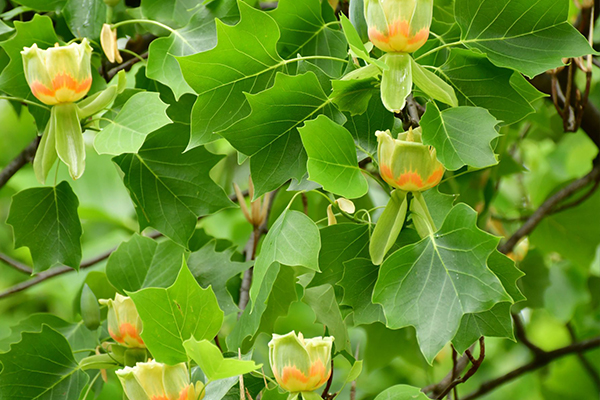
Columnar Tulip Tree
Common Name: Columnar Tulip Tree
Botanical Name: Liriodendron tulipifera fastigiata
Height: 50–60 feet
Spread: 8–10 feet
Location: Full sun to part shade
Bloom: April, yellow and orange
Hardiness zone 4–9
The Columnar Tulip Tree is a member of the Magnolia family and derives from one of the largest native trees in North America. It has distinct tulip-shaped characteristics in its leaves, its cup-shaped flowers, and its conelike fruit that sits upright on the branches. The beautiful golden-yellow color adds to the appeal of this narrow-growing landscape tree.
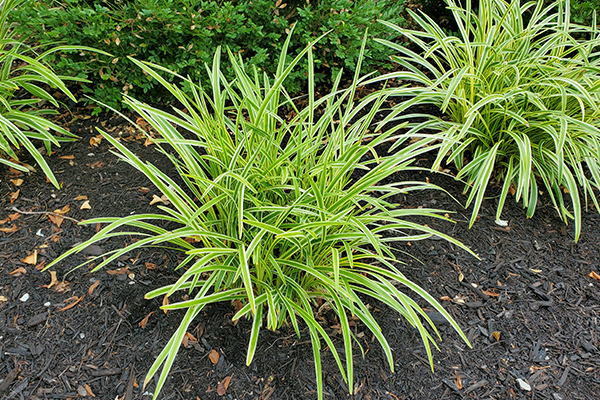
Variegated Lilyturf
Common Name: Variegated Lilyturf
Botanical Name: Liriope muscari variegata
Height: 1–1.5 feet
Spread: 1–3 feet
Location: Full sun to part shade
Bloom: August, Purple flower
Hardiness zone 5–11
We love Liriope as a border plant, but we also use it in groupings throughout the Botanical Gardens. Be careful to read the growth habits for your liriope before planting. Our variegated variety “Muscari Variegate” grows in clumps increasing in size every year. Our solid green variety, “Big Blue,” is a ground-covering plant and will take over an area that you may not want. They look very similar in the pot when you purchase, so we suggest reading before planting, as with all plants. Both our types of Liriope have violet–purple flowers, although some white varieties are available. They bloom in late summer, giving way to black berries that persist into the winter. They are perennials, so we cut them back, but we wait until late in the winter since the foliage holds its color. They return in the spring with new growth, ready for another growing season.
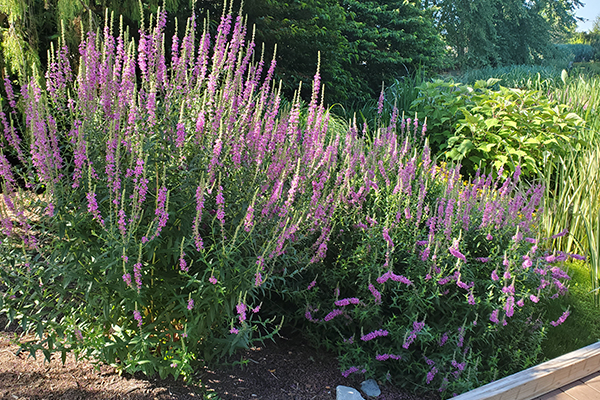
Morden's Pink Loosestrife
Common Name: Morden's Pink Loosestrife
Botanical Name: Lythrum virgatum
Height: 2–4 feet
Spread: 2–3 feet
Location: Full sun part shade
Bloom: All summer, pink flower
Hardiness zone 4–9
Most Lythrum varieties are invasive and can produce millions of small seeds per season. The seeds are small enough to move around on water, stick to an animal, or translocate unknowingly by humans. They can easily take over an unwanted area, so it is important to understand what you are planting so that you can care for it properly. Thankfully, our variety “Morden’s” is sterile, so we do not need to worry about the invasive characteristics. This is a spectacular plant in full bloom and a vigorous grower. It has long beautiful pink flower spikes that you can enjoy all summer.
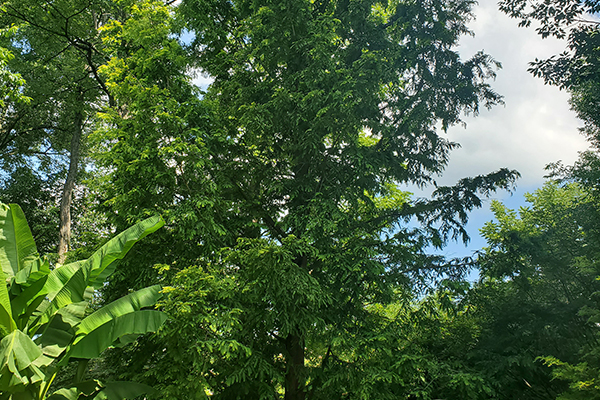
Dawn Redwood
Common Name: Dawn Redwood
Botanical Name: Metasequoia glyptostroboides
Height: 70–100 feet
Spread: 15–25 feet
Location: Full sun
Bloom: non-flowering
Hardiness zone 4–8
Dawn Redwood was once thought to be extinct until 1944 when it was discovered growing in central China. It is closely related to the bald cypress and the very large sequoia redwoods. It is a fast growing, deciduous tree that is also a conifer—in other words, it drops its “leaves” that look like needles in the fall, and it produces cones like many other evergreens. The needles are softer than most evergreens, and they turn a rust color in the fall before dropping to expose the beautiful, fluted trunk with somewhat shaggy bark. This big and bold tree has proven to be adaptable to most soil types and easy to grow.

First Lady Water Lotus
Common Name: First Lady Water Lotus
Botanical Name: Nelumbo
Height: 4–5 feet
Spread: 3–4 feet
Location: Full sun
Bloom: Pink, lavender-pink or light pink
Hardiness zone 4–11
A sight to behold! First Lady Water Lotus is a marginal aquatic perennial with an impressive umbrella-like leaf reaching 2 feet across and often rising 4–5 feet above the water line. The most striking characteristic is the large, fragrant, pink or lavender-pink bloom that grows to 8 inches across and stands high above the foliage. The usually yellow or light green cone-shaped fruit is in the center of the flower and is often used in flower arrangements.
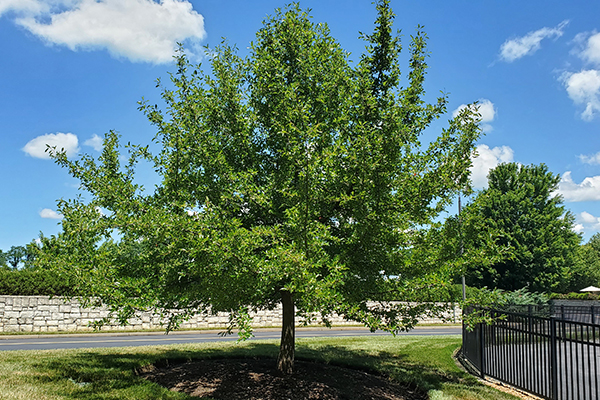
Black Gum
Common Name: Black Gum
Botanical Name: Nyssa sylvatica tupelo
Height: 30–50 feet
Spread: 20–30 feet
Location: Full sun to part shade
Bloom: May–June, white
Hardiness zone 4–9
Black Gum is a popular Eastern US native tree known as one of the first to change the color of its leaves in the fall. While the leaves are a glossy green in the summer, a variety of yellow, orange, red, and even purple may appear on the same branch in the fall. They also have a white flower in the spring, followed by a bluish black fruit that many birds love. There are no serious insect or disease problems on this ornamental shade tree that may look great in your garden.

Purple Pickerel Weed
Common Name: Purple Pickerel Weed
Botanical Name: Pontederia
Height: 1–5 feet
Spread: 1–3 feet
Location: Full sun to part shade
Bloom: June–September, purple
Hardiness zone
The Pickerel Weed plant produces a single spike of small purple flowers often rising above the 3-foot tall, heart-shaped leaves. It has a wind-protective leaf that grows behind the flower, and it blooms in succession from the bottom up, extending the bloom for several days. This is an emergent aquatic with its leaves and flowers above the water and portions of the stem under water.

Radrazz Knockout Rose
Common Name: Radrazz Knockout Rose
Botanical Name: Rosa
Height: 3–4 feet
Spread: 3–4 feet
Location: Full sun to part shade
Bloom: June to frost, Cherry red
Hardiness zone 5–11
The Radrazz is the original member of the Knockout family and is still one of the best performers of the group. It is resistant, although not impervious, to the standard diseases, making it require little care compared to other roses. We cut the Botanical Garden’s roses back by two thirds in the early spring, and they flush out with new growth and new color every year. The color lasts all summer until the first frost, making this rose an easy pick for a garden.
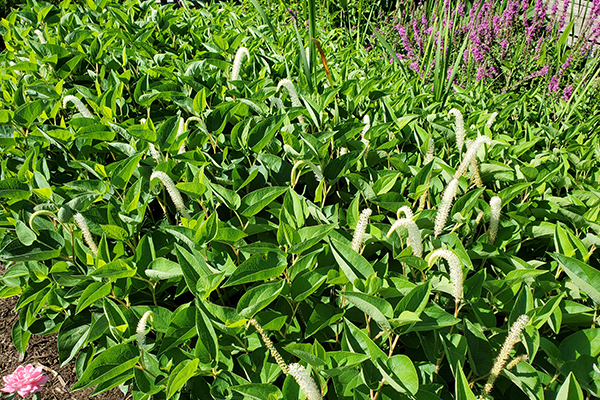
Lizard’s Tail
Common Name: Lizard’s Tail
Botanical Name: Saururus cernuus
Height: 1–5 feet
Spread: 1–2 feet
Location: Full sun to part sun
Bloom: April–August, white
Hardiness zone 4–11
Lizard’s tail is an upright, marginal aquatic perennial. The name refers to the finger-like flowers that appear during the summer months. The 24-inch branching stems have dark green, heart-shaped leaves that are 3–6 inches long. This is a spreading groundcover for wetland areas and can colonize a large area if not controlled. It is virtually pest and disease free and also deer resistant.

Bald Cypress
Common Name: Bald Cypress
Botanical Name: Taxodium distichum
Height: 50–70 feet
Spread: 20–30 feet
Location: Full sun to part shade
Bloom: inconspicuous
Hardiness zone 4–11
Unlike most cone-bearing trees, Bald Cypress is deciduous and loses its needles each winter, growing a new set in the spring. This Midwest native is a common sight around lakes but is adaptable to a variety of soil conditions, so you may also see it in park groupings or along streets. The rusty red fall color is one of its identifiable characteristics that stands out among other trees. Another is the interesting part of the root system known as “knees” that you will find when they are planted near water.

Thalia
Common Name: Thalia
Botanical Name: Thalia dealbata
Height: 3–6 feet
Spread: 6–10 feet
Location: Full sun
Bloom: All summer, purple flower
Hardiness zone 3–10
Also known as water canna, this is a bold, tropical-looking plant. It is in the marginal aquatic category of perennial plants, so it either needs to be planted on the edge of a water source or in a very wet area for its survival. Thalia forms a dramatic clump of blue-green leaves that have a white powder on them. Some call this plant “Powdery Alligator-Flag” because of its characteristics. It has panicles of small purple flower that appear most of the summer on long slender stems well above the foliage.

Winterthur Viburnum
Common Name: Winterthur Viburnum
Botanical Name: Viburnum nudum
Height: 5–12 feet
Spread: 5–12 feet
Location: Full sun to part shade
Bloom: April–May, white flower
Hardiness zone 5–9
Winterthur is a multi-stemmed cultivar of Viburnum Nudum which is native to the eastern U.S. and can be found in lower lands or boggy areas. It has white clusters of flowers contrasting its shiny green leaves in the spring followed by berries ranging from pink to blue in the fall. The berries normally hold on the plant into the winter for more seasonal interest.
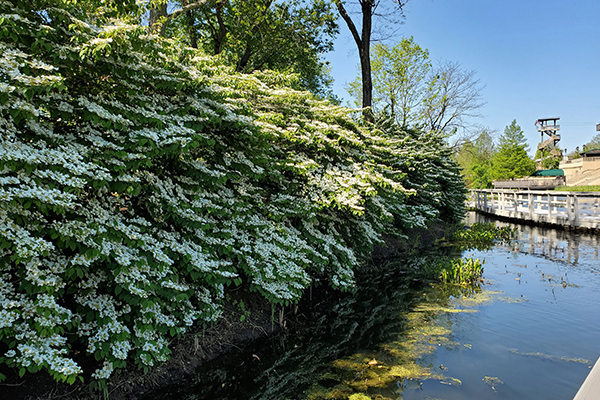
Doublefile Viburnum
Common Name: Doublefile Viburnum
Botanical Name: Viburnum plicatum var. tomentosum ‘Mariesii’
Height: 8–16 feet
Spread: 12–15 feet
Location: Full sun to part shade
Bloom: April–May, white flower
Hardiness zone 5–8
Doublefile viburnum is named for its double rows or files of white flowers that appear profusely along its horizontal branching in April or May. After the flowering season is over, the red-berried fruit will appear to change to black as the season progresses, and the green leaves turn to a beautiful auburn red. The fruit is attractive and a good late-season food source for birds. This multi-stemmed shrub will thrive in a variety of soils, but it does prefer ample moisture. The Creation Museum Botanical Gardens uses this plant as a divider or “wall” that separate garden areas, although you could plant this as an individual specimen in your garden.
